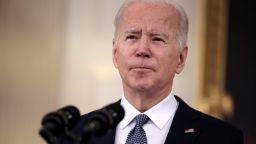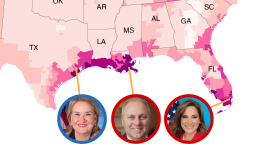A version of this story appeared in CNN’s What Matters newsletter. To get it in your inbox, sign up for free here
A level of devastation “unlike anything I have ever seen.”
That’s how Kentucky Gov. Andy Beshear described the series of tornadoes that ripped through several states in the Midwest and South this weekend, transforming homes and businesses into piles of rubble.
Over 100 people are feared dead.
While FEMA administrator Deanne Criswell said events like this would be “our new normal” in the age of climate change, President Joe Biden was more cautious on Saturday, telling reporters it’s too early to know the specific effect climate change had on this week’s storms.
“All that I know is that the intensity of the weather across the board has some impacts as a consequence of the warming of the planet, and the climate change – the specific impact, on these specific storms, can’t say at this point,” adding he’d be tasking the Environmental Protection Agency and other agencies “to take a look at that.”
“But the fact is that we all know everything is more intense when the climate is warming everything, and obviously it has some impact here, but I can’t give you a quantitative read on that,” Biden said.
The President’s comments underscore the nuance of understanding extreme weather events within the context of climate change. While warming temperatures have unequivocally spawned more intense weather events in the aggregate, linking specific events to climate change can be tricky.
Research on the role that climate change is playing in the formation and intensity of tornadoes is not as robust as for other types of extreme weather like droughts, floods and even hurricanes. The nature of tornadoes, along with an extremely spotty and unreliable historical record for them, makes drawing connections to long-term, human-caused climate change very difficult.
While establishing connections between climate change and tornadoes is difficult, the correlation between El Niño/La Niña and tornadoes is strong. La Niña seasons tend to have increased tornado activity in the US, and it is worth noting that the US is currently experiencing La Niña, which is expected to last into spring of next year.
For help understanding the role of climate change in extreme weather events, we turned to Scott Sklar, the energy director of George Washington University’s Environment & Energy Management Institute. Our conversation, which has been lightly edited for length and clarity, is below.
CNN: Can you explain the relationship between what we know about climate change and the formation of tornadoes. And also the connection between climate change and extreme weather events more generally?
SS: First of all, there have been many different studies on severe weather in the aggregate. And we’re talking about flooding, ocean surges, forest fires and hurricane intensity. So we have some very good documentation, many peer-reviewed studies on all of that.
What we don’t have is something comparable with tornadoes. What we do know is we’re not getting more tornadoes, but we do know that hot weather helps spawn tornadoes, particularly when there’s a meeting of hot and cold fronts coming together. They cause swirls and that’s very well-known and documented. And in this case of the horrible tornadoes – the tornado, the longest one so far in history – we do know that it was in the 70s to near 80s Friday afternoon. And that is very out of character for December in that area.
So what we know about tornadoes is that while we’re not getting more tornadoes, they’re clumping together in certain timeframes, and this is one of the timeframes they’re starting to clump together. And that’s all we know. We really don’t know the science really behind that or what’s causing that or whether that could just be an aberration at this point. But we do know hotter temperatures do create that formation period for tornadoes. And we are getting those hot temperatures.
CNN: President Joe Biden said this weekend it’s too early to know whether these tornadoes were spawned by climate change but that he would ask the Environmental Protection Agency to assess. What goes into an assessment like that?
SS: They’re going to tap into other federal agencies like the National Oceanic and Atmospheric Administration, which sits within the Department of Commerce. NASA, they have a weather science group, and they’re going to pull all the existing data together of the day before to present and take a look at those conditions in much more detail. Then they’re going to bring in a meteorologist not only from the federal government, from the different universities that study different parts of that, both Environmental Protection Agency laboratories, national laboratories and other federal laboratories, and just look at that data and see if anything, you know, fits these criteria that we know.
And I just have to say, we don’t have enough science at the moment on tornadoes. We really haven’t looked in detail on climate on tornadoes. So I want to be clear that we don’t know if climate change created this situation at the moment, but we also don’t know if it didn’t. And so it’s just where we are scientifically.
CNN: So how do you get people to feel the urgency of climate change when linking it to specific weather tragedies can be quite nuanced?
SS: The National Oceanic and Atmospheric Administration puts out these great maps of extreme weather events that cost over $1 billion every year. I put them on slides for my students, and it’s sobering to see what’s happened over the last 20, 25 years in that we started with maybe one or two events and now we’re averaging seven to 12 events a year.
So we know extreme events are just happening more frequently. We also know, again, that ocean surges, flooding, hurricanes and these extreme forest fires are absolutely related to climate change. So we know that those events that have been on the news – including extreme cold snaps in Texas, which brought down the entire Texas grid – were related to extremes in climate, extreme patterns. And so that’s what we know. Part of it is to say, ‘Okay, we’re seeing these more extreme events, even if it were not related to climate, we need to prepare for those extreme events.’
So that’s one of the issues I tell people – even, for some reason, if you don’t think the preponderance of scientific evidence makes any sense, we do know we’re having more extreme events. And so we are going as a country, and of course as a world, to prepare for them – things that we have not had to prepare for before. And that includes how we zone on where we put buildings, how we build buildings, how we build roadways, how we harden our infrastructure. Every time we get a high wind, like we did in this area in Northern Virginia last night, people are not sitting there without power in the winter or the summer, in particular. We have a lot of work to do.
But I’m here to say that these are very sobering statistics, and they’re not coincidental. And so that is the issue we’re dealing with.
CNN: There always seems to be some climate change discussion in the wake of horrific events. You mentioned the Texas energy grid, but how do you sustain the urgency of that discussion beyond an extreme weather event?
SS: That’s why having these kind of maps put out by different scientific agencies is so important. It’s staggering when you take a look at the history of extreme events and what’s happening in my lifetime.
But you know, the other thing is we need to be careful. I really believe some of the pushback on this is the average human being says, ‘Okay, I may believe in it, but I’m sort of at wit’s end to say what do I really do with that? And I’m being told so many different things and it’s confusing and overwhelming to me.’
And so that’s the other part of this – to create some concrete action that allows people to feel they’re moving the needle without being told there are a hundred different things they have to do and just getting overwhelmed and shutting it out.
CNN: I suppose that’s the heart of the issue, boiling down a global problem into something individuals can take concrete steps to address?
SS: What I have been doing as an educator is going to local governments and saying, ‘Look, you know, part of this is to take a look at things that are not only doable, but save people money at the same time.’
So, you know, weatherizing your home, buying appliances more efficiently so they’re just using less energy – because it’s always less expensive to save energy than generate it from any source. So let’s focus on the things people can do to save money, because that’s a great thing to have more disposable income. And if that has a major impact on climate, that’s the perfect juxtaposition of doing things for economic value and climate value.
I think we need to start looking at those things and just not overwhelming folks that are trying to work, and provide for their families, and deal with their health issues and all sorts of things.







